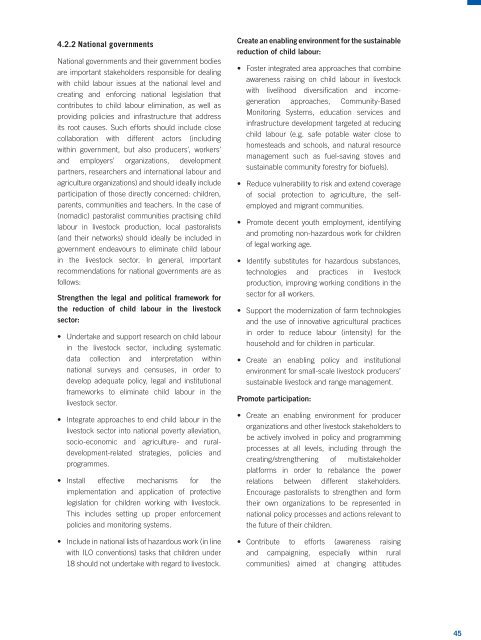Children’s work in the livestock sector: Herding and beyond
Children’s work in the livestock sector: Herding and beyond
Children’s work in the livestock sector: Herding and beyond
Create successful ePaper yourself
Turn your PDF publications into a flip-book with our unique Google optimized e-Paper software.
4.2.2 National governments<br />
National governments <strong>and</strong> <strong>the</strong>ir government bodies<br />
are important stakeholders responsible for deal<strong>in</strong>g<br />
with child labour issues at <strong>the</strong> national level <strong>and</strong><br />
creat<strong>in</strong>g <strong>and</strong> enforc<strong>in</strong>g national legislation that<br />
contributes to child labour elim<strong>in</strong>ation, as well as<br />
provid<strong>in</strong>g policies <strong>and</strong> <strong>in</strong>frastructure that address<br />
its root causes. Such efforts should <strong>in</strong>clude close<br />
collaboration with different actors (<strong>in</strong>clud<strong>in</strong>g<br />
with<strong>in</strong> government, but also producers’, <strong>work</strong>ers’<br />
<strong>and</strong> employers’ organizations, development<br />
partners, researchers <strong>and</strong> <strong>in</strong>ternational labour <strong>and</strong><br />
agriculture organizations) <strong>and</strong> should ideally <strong>in</strong>clude<br />
participation of those directly concerned: children,<br />
parents, communities <strong>and</strong> teachers. In <strong>the</strong> case of<br />
(nomadic) pastoralist communities practis<strong>in</strong>g child<br />
labour <strong>in</strong> <strong>livestock</strong> production, local pastoralists<br />
(<strong>and</strong> <strong>the</strong>ir net<strong>work</strong>s) should ideally be <strong>in</strong>cluded <strong>in</strong><br />
government endeavours to elim<strong>in</strong>ate child labour<br />
<strong>in</strong> <strong>the</strong> <strong>livestock</strong> <strong>sector</strong>. In general, important<br />
recommendations for national governments are as<br />
follows:<br />
Streng<strong>the</strong>n <strong>the</strong> legal <strong>and</strong> political frame<strong>work</strong> for<br />
<strong>the</strong> reduction of child labour <strong>in</strong> <strong>the</strong> <strong>livestock</strong><br />
<strong>sector</strong>:<br />
Undertake <strong>and</strong> support research on child labour<br />
<strong>in</strong> <strong>the</strong> <strong>livestock</strong> <strong>sector</strong>, <strong>in</strong>clud<strong>in</strong>g systematic<br />
data collection <strong>and</strong> <strong>in</strong>terpretation with<strong>in</strong><br />
national surveys <strong>and</strong> censuses, <strong>in</strong> order to<br />
develop adequate policy, legal <strong>and</strong> <strong>in</strong>stitutional<br />
frame<strong>work</strong>s to elim<strong>in</strong>ate child labour <strong>in</strong> <strong>the</strong><br />
<strong>livestock</strong> <strong>sector</strong>.<br />
Integrate approaches to end child labour <strong>in</strong> <strong>the</strong><br />
<strong>livestock</strong> <strong>sector</strong> <strong>in</strong>to national poverty alleviation,<br />
socio-economic <strong>and</strong> agriculture- <strong>and</strong> ruraldevelopment-related<br />
strategies, policies <strong>and</strong><br />
programmes.<br />
Install effective mechanisms for <strong>the</strong><br />
implementation <strong>and</strong> application of protective<br />
legislation for children <strong>work</strong><strong>in</strong>g with <strong>livestock</strong>.<br />
This <strong>in</strong>cludes sett<strong>in</strong>g up proper enforcement<br />
policies <strong>and</strong> monitor<strong>in</strong>g systems.<br />
Include <strong>in</strong> national lists of hazardous <strong>work</strong> (<strong>in</strong> l<strong>in</strong>e<br />
with ILO conventions) tasks that children under<br />
18 should not undertake with regard to <strong>livestock</strong>.<br />
Create an enabl<strong>in</strong>g environment for <strong>the</strong> susta<strong>in</strong>able<br />
reduction of child labour:<br />
Foster <strong>in</strong>tegrated area approaches that comb<strong>in</strong>e<br />
awareness rais<strong>in</strong>g on child labour <strong>in</strong> <strong>livestock</strong><br />
with livelihood diversification <strong>and</strong> <strong>in</strong>comegeneration<br />
approaches, Community-Based<br />
Monitor<strong>in</strong>g Systems, education services <strong>and</strong><br />
<strong>in</strong>frastructure development targeted at reduc<strong>in</strong>g<br />
child labour (e.g. safe potable water close to<br />
homesteads <strong>and</strong> schools, <strong>and</strong> natural resource<br />
management such as fuel-sav<strong>in</strong>g stoves <strong>and</strong><br />
susta<strong>in</strong>able community forestry for biofuels).<br />
Reduce vulnerability to risk <strong>and</strong> extend coverage<br />
of social protection to agriculture, <strong>the</strong> selfemployed<br />
<strong>and</strong> migrant communities.<br />
Promote decent youth employment, identify<strong>in</strong>g<br />
<strong>and</strong> promot<strong>in</strong>g non-hazardous <strong>work</strong> for children<br />
of legal <strong>work</strong><strong>in</strong>g age.<br />
Identify substitutes for hazardous substances,<br />
technologies <strong>and</strong> practices <strong>in</strong> <strong>livestock</strong><br />
production, improv<strong>in</strong>g <strong>work</strong><strong>in</strong>g conditions <strong>in</strong> <strong>the</strong><br />
<strong>sector</strong> for all <strong>work</strong>ers.<br />
Support <strong>the</strong> modernization of farm technologies<br />
<strong>and</strong> <strong>the</strong> use of <strong>in</strong>novative agricultural practices<br />
<strong>in</strong> order to reduce labour (<strong>in</strong>tensity) for <strong>the</strong><br />
household <strong>and</strong> for children <strong>in</strong> particular.<br />
Create an enabl<strong>in</strong>g policy <strong>and</strong> <strong>in</strong>stitutional<br />
environment for small-scale <strong>livestock</strong> producers’<br />
susta<strong>in</strong>able <strong>livestock</strong> <strong>and</strong> range management.<br />
Promote participation:<br />
Create an enabl<strong>in</strong>g environment for producer<br />
organizations <strong>and</strong> o<strong>the</strong>r <strong>livestock</strong> stakeholders to<br />
be actively <strong>in</strong>volved <strong>in</strong> policy <strong>and</strong> programm<strong>in</strong>g<br />
processes at all levels, <strong>in</strong>clud<strong>in</strong>g through <strong>the</strong><br />
creat<strong>in</strong>g/streng<strong>the</strong>n<strong>in</strong>g of multistakeholder<br />
platforms <strong>in</strong> order to rebalance <strong>the</strong> power<br />
relations between different stakeholders.<br />
Encourage pastoralists to streng<strong>the</strong>n <strong>and</strong> form<br />
<strong>the</strong>ir own organizations to be represented <strong>in</strong><br />
national policy processes <strong>and</strong> actions relevant to<br />
<strong>the</strong> future of <strong>the</strong>ir children.<br />
Contribute to efforts (awareness rais<strong>in</strong>g<br />
<strong>and</strong> campaign<strong>in</strong>g, especially with<strong>in</strong> rural<br />
communities) aimed at chang<strong>in</strong>g attitudes<br />
45


